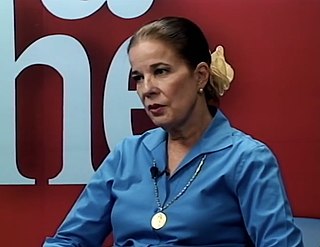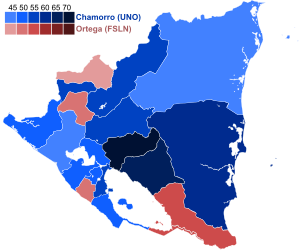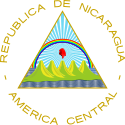
The Contras were the various U.S.-backed-and-funded right-wing rebel groups that were active from 1979 to 1990 in opposition to the Marxist Sandinista Junta of National Reconstruction Government in Nicaragua, which had come to power in 1979 following the Nicaraguan Revolution. Among the separate contra groups, the Nicaraguan Democratic Force (FDN) emerged as the largest by far. In 1987, virtually all Contra organizations were united, at least nominally, into the Nicaraguan Resistance.

José Daniel Ortega Saavedra is a Nicaraguan politician who has served as the 58th president of Nicaragua since 2007. Previously he was leader of Nicaragua from 1979 to 1990, first as Coordinator of the Junta of National Reconstruction from 1979 to 1985, and then as the 54th President from 1985 to 1990. During his first term, he implemented policies to achieve leftist reforms across Nicaragua. In later years, Ortega's left-wing radical politics cooled significantly, leading him to pursue pro-business policies and even rapprochement with the Catholic Church. However, in 2022, Ortega resumed repression of the Church, and has imprisoned prelate Rolando José Álvarez Lagos.
Nicaragua is a nation in Central America. It is located about midway between Mexico and Colombia, bordered by Honduras to the north and Costa Rica to the south. Nicaragua ranges from the Caribbean Sea on the nation's east coast, and the Pacific Ocean bordering the west. Nicaragua also possesses a series of islands and cays located in the Caribbean Sea.

The Sandinista National Liberation Front is a left-wing political party in Nicaragua. Its members are called Sandinistas in both English and Spanish. The party is named after Augusto César Sandino, who led the Nicaraguan resistance against the United States occupation of Nicaragua in the 1930s.

Violeta Barrios Torres de Chamorro is a Nicaraguan former politician who served as the 55th President of Nicaragua from 1990 to 1997. She was the first and, to date, only woman to hold the position of president of Nicaragua. Previously, she was a member of the Junta of National Reconstruction from 1979 to 1980.

The Nicaraguan Revolution encompassed the rising opposition to the Somoza dictatorship in the 1960s and 1970s, the campaign led by the Sandinista National Liberation Front (FSLN) to oust the dictatorship in 1978–79, the subsequent efforts of the FSLN to govern Nicaragua from 1979 to 1990, and the Contra War, which was waged between the FSLN-led government of Nicaragua and the United States–backed Contras from 1981 to 1990. The revolution marked a significant period in the history of Nicaragua and revealed the country as one of the major proxy war battlegrounds of the Cold War, attracting much international attention.
Anastasio Somoza Portocarrero is a Nicaraguan American colonel and businessman.

The Junta of National Reconstruction was the provisional government of Nicaragua from the fall of the Somoza dictatorship in July 1979 until January 1985, with the election of Sandinista National Liberation Front’s Daniel Ortega as president.
La Prensa is a Nicaraguan newspaper, with offices in the capital Managua. Its current daily circulation is placed at 42,000. Founded in 1926, in 1932 it was bought by Pedro Joaquín Chamorro Zelaya, who had become editor-in-chief. He promoted the Conservative Party of Nicaragua and became a voice of opposition to Juan Bautista Sacasa, for which the paper was censored. He continued to be critical of dictator Anastasio Somoza García, who came to power in a coup d'état.

General Humberto Ortega Saavedra is a Nicaraguan military leader, Latin American revolutionary strategist, and published writer. He was Minister of Defense between the victory of the Sandinista revolution in 1979 under the National Reconstruction Government, through the first presidency of his brother Daniel Ortega, and through the presidency of Violeta Barrios de Chamorro who defeated Daniel Ortega in the elections of 1990.
Women played a role in the Nicaraguan Revolution. Those who joined the Sandinista movement in the revolutionary Nicaragua essentially fought a battle: to secure national freedom from the Somoza dictatorship and to advance gender equality.

National Opposition Union was a Nicaraguan wide-range coalition of opposition parties formed to oppose president Daniel Ortega's Sandinista National Liberation Front (FSLN) in the 1990 election. Its candidate Violeta Chamorro eventually won the race. UNO traced its origins back to the Nicaraguan Democratic Coordinating Group, which was formed in 1982 by different opposition groups. At the time of the election, of the UNO coalition's fourteen political parties, four were considered conservative, seven could be characterised as centrist parties, and three – including Nicaragua's Communists – had traditionally been on the far left of the political spectrum.

Arturo José Cruz Porras, sometimes called Arturo Cruz Sr. to distinguish him from his son, was a Nicaraguan banker and technocrat. He became prominent in politics during the Sandinista (FSLN) era. After repeatedly resigning from positions in protest, opinion divided between those who lauded him as a statesman and man of principle, and those who derided him as an ineffectual hand-wringer.
In 1979, the Sandinista National Liberation Front (FSLN) overthrew Anastasio Somoza Debayle, ending the Somoza dynasty, and established a revolutionary government in Nicaragua. Following their seizure of power, the Sandinistas ruled the country first as part of a Junta of National Reconstruction. Following the resignation of centrist members from this Junta, the FSLN took exclusive power in March 1981.

Claudia Lucía Chamorro Barrios is a Nicaraguan writer, public health official, and former ambassador of Nicaragua to Cuba and Costa Rica. She served as a diplomat on behalf of the Sandinista government in the 1980s. She later became a critic of the FSLN. She is the author of a memoir, Tiempo de Vivir.

Mariano Fiallos Oyanguren was a Nicaraguan judge and academic. He was rector of National Autonomous University of Nicaragua at León (UNAN-León) from 1974 to 1980 and President of the Supreme Electoral Council from 1984 to 1996, overseeing the country’s first democratic transfer of power in 1990.

Oscar Manuel Sobalvarro Garcia is a former commander in the Nicaraguan Resistance fighting the Sandinista National Liberation Front, of which he was a former army soldier. Professionally he was a farmer and salesman. His nom-de-guerre was "Commandante Ruben."

Cristiana Chamorro Barrios is a Nicaraguan journalist, nonprofit executive and political candidate. Vice-president of La Prensa, she was an aspiring presidential candidate in the 2021 Nicaraguan general election until the Ortega government disqualified her from running and ordered her arrest in early June 2021.
Pedro Joaquín Chamorro Barrios is a Nicaraguan journalist and politician. He began his career in journalism working at La Prensa, following the 1978 assassination of its editor, his father, Pedro Joaquín Chamorro Cardenal. Working on the side of the Contras in exile in the 1980s, he returned to the country in 1989 when his mother Violeta Barrios de Chamorro ran for president, and following her election, served as a Nicaraguan ambassador. He later became defense minister. In the 21st century, Chamorro has been a city councilor for Managua and deputy in the National Assembly, also for Managua. On 25 June 2021, he became part of a wave of arrests of opposition and civic figures in Nicaragua.

Jaime Chamorro Cardenal was a Nicaraguan newspaper editor and publisher. A civil engineer by training, journalism was the family business, as his father owned the newspaper La Prensa. Chamorro joined La Prensa in 1974, where he worked for 47 years and served as publisher for 28, from 1993 until his death in 2021.



















